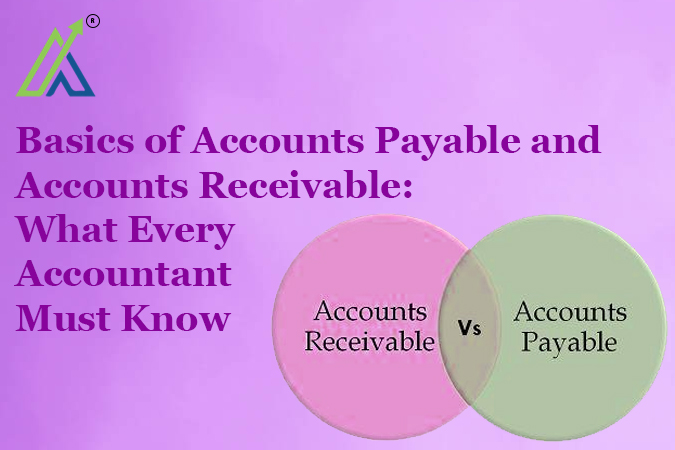Cash coming in and out are the two unseen motors that power any firm. These engines are a treasure trove for accountants. The foundation of this apparatus is made up of accounts payable (AP) and accounts receivable (AR). The system will malfunction if you mess things up. If you master them, you’ll be the unsung hero responsible for efficient operations. Let’s go past the technicalities and explain what these phrases represent, how they operate in India, and why they are essential to financial stability.
Accounts Payable vs Accounts Receivable
Consider accounts payable as your “to-pay” file. It is the debt your company owes suppliers, vendors, or tax authorities. Conversely, accounts receivable is your “to-collect” list—the money people owe you for goods or services supplied. Straight forward? Not rather. In India, where vendor negotiations, TDS deductions, and GST compliance rule, AP and AR necessitate accuracy.
- Accounts Payable Cycle: Starts when you receive a bill or invoice. Verify it (check GST details, purchase order matching), approve it, schedule payment (factoring in credit terms like “Net 30”), and finally, record the transaction. One slip-up here—like missing a TDS cut-off—can mean penalties or pissed-off suppliers.
- Accounts Receivable Cycle: Begins with invoicing clients. Send the bill (with proper GSTIN and HSN codes), track due dates, follow up relentlessly (because late payments are an epidemic), and log receipts. Missed follow-ups? Say hello to cash crunches.
The difference? AP is about managing outflows (don’t pay late, but don’t pay too early either). AR is about accelerating inflows (get cash faster, always). Both cycles keep the business alive.
Accounts Payable Journal Entries: Recording the Outflow
Every rupee leaving the company needs a paper trail. Let’s say you buy raw materials worth ₹1,00,000 from a vendor, with 18% GST. Here’s how it looks:
- Purchase Entry:
- Debit: Purchase Account – ₹1,00,000
- Debit: GST Input Credit – ₹18,000
- Credit: Accounts Payable – ₹1,18,000
- Payment Entry (when you clear the dues):
- Debit: Accounts Payable – ₹1,18,000
- Credit: Bank Account – ₹1,18,000
Forget to reverse input credits? The taxman will hunt you down.
Accounts Receivable Journal Entries: Tracking the Inflow
Sold goods worth ₹2,50,000 to a client with 12% GST? Here’s the drill:
- Sales Entry:
- Debit: Accounts Receivable – ₹2,80,000
- Credit: Sales Account – ₹2,50,000
- Credit: GST Output Liability – ₹30,000
- Receipt Entry (when payment lands):
- Debit: Bank Account – ₹2,80,000
- Credit: Accounts Receivable – ₹2,80,000
Pro tip: Always reconcile AR balances with GST returns. Mismatches? Instant red flags during audits.
Accounts Payable Management
Managing AP isn’t about paying bills on time. It’s strategy.
- Negotiate Terms: Stretch payment periods without burning vendor relationships. “Net 45” instead of “Net 30”? Yes, please.
- Leverage Discounts: Some suppliers offer 2% off for early payments. Crunch the numbers—sometimes saving ₹2,000 on a ₹1 lakh bill beats holding cash.
- Automate: Use software to track due dates, auto-calculate TDS, and generate payment schedules. Manual tracking? A one-way ticket to errors.
In India, AP management also means staying sharp on GST input claims. Lost invoices mean lost credits—direct hit on profits.
Accounts Receivable Management
AR management is a mix of charm and aggression.
- Credit Policies: Check a client’s CIBIL score before offering credit. Trust everyone? Prepare to bleed cash.
- Aging Reports: Classify dues as 0-30 days, 31-60 days, etc. Stuck with 90+ days? Escalate. Send reminders, charge interest (yes, you can legally do this), or threaten legal notices under the Companies Act.
- Factor Receivables: Sell overdue invoices to banks or NBFCs for instant cash (at a discount). Not ideal, but better than a liquidity crisis.
Bonus: Use GST-compliant invoices. No proper HSN codes? Say goodbye to input credits for your clients—and expect delayed payments.
The Reasons AP and AR Are Inseparable
AP and AR aren’t rivals—they’re partners. Strong accounts payable management ensures suppliers stay happy, keeping your supply chain intact. Efficient accounts receivable management keeps cash flowing, funding day-to-day ops. Together, they balance the working capital cycle. Ignore one, and the other collapses.
In India, where businesses juggle MSME compliance, GST filings, and tight margins, mastering both cycles isn’t optional. It’s survival.
Questions to Understand your Ability
Q1.) What is the primary difference between Accounts Payable (AP) and Accounts Receivable (AR)?
a) AP deals with managing the inflow of cash, and AR handles outflows
b) AP manages payments the business owes, while AR tracks payments owed to the business
c) AP is about taxes, and AR is about financial planning
d) AP is for goods bought, and AR is for goods sold
Q2.) Which of the following is a key step in the Accounts Payable (AP) cycle?
a) Send reminders to clients
b) Verify GST details and match purchase orders
c) Offer early payment discounts to clients
d) Negotiate better credit terms with customers
Q3.) In Accounts Receivable (AR) management, what should you do if you are stuck with 90+ days overdue invoices?
a) Wait for the client to pay
b) Offer a discount to encourage payment
c) Send reminders, charge interest, or escalate to legal action
d) Ignore the overdue payment
Q4.) When managing Accounts Payable (AP), what is a recommended strategy for handling supplier relationships?
a) Always pay as early as possible
b) Negotiate for longer payment periods without damaging relationships
c) Avoid automating AP processes
d) Never negotiate payment terms
Q5.) Why is it important to reconcile Accounts Receivable (AR) balances with GST returns?
a) To avoid delays in payments
b) To ensure accurate tax reporting and avoid audit red flags
c) To calculate interest on overdue payments
d) To maintain a good credit score
Conclusion
Accounts payable and accounts receivable aren’t just “accounting topics.” They’re the heartbeat of your business’s cash flow. Learn the cycles, nail the journal entries, and manage them like a pro. Whether you’re dealing with a local vendor in Chennai or a corporate client in Mumbai, the rules stay the same: Track diligently, enforce ruthlessly, reconcile religiously.
FAQ's
AP is the money your business owes to others (suppliers, vendors, tax authorities), while AR is the money others owe you for goods or services provided.
It begins when you receive an invoice, verify it (check GST, purchase orders), approve it, schedule the payment, and record the transaction.
It starts when you send an invoice to clients, track due dates, follow up on payments, and record the receipt of cash.
You debit the purchase account and GST input credit, and credit accounts payable when a purchase is made. Upon payment, debit accounts payable and credit the bank account.
Debit accounts receivable and credit sales and GST output liability when sales are made. Upon receipt of payment, debit the bank account and credit accounts receivable.
Negotiate longer payment terms, leverage early payment discounts, and automate AP processes to avoid errors and ensure GST claims are accurately filed.
Check a client’s credit score before offering credit, classify dues in aging reports, and escalate overdue payments by sending reminders, charging interest, or sending legal notices.
AP ensures that suppliers are paid on time to maintain the supply chain, while AR ensures cash inflows. Both are essential to managing working capital and business survival.




